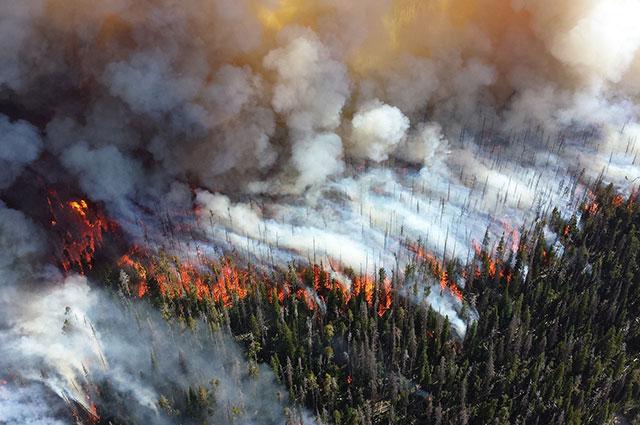-
About
- Departments & Offices
-
Academics
- Physician Assistant
- Special Master’s (MBS)
-
Admissions & Financial Aid
- Tuition & Fees
-
Student Life
-
Research
- Research Labs & Centers
-
Local & Global Engagement
- Global Health Programs
- Community Engagement
Estimating the Health Effects of Wildfires: A Burning Concern
A Tufts environmental epidemiologist explains why this is such a challenging task for scientists—and how research can make a difference

Growing up with asthma in Colorado, Laura Corlin, A13, EG15, EG18, an environmental epidemiologist at Tufts University School of Medicine, remembers how wildfire season affected her everyday life.
“Summer wildfires sometimes meant that I couldn’t go outside without coughing,” said Corlin who—even now—has to minimize her exposure to asthma attack triggers such as pollution and cigarette smoke.
Corlin’s personal experiences inspired her to study environmental health issues, which have been the focus of her career at Tufts, first as a student and now as a new professor of public health and community medicine. Her current research focuses on measuring and understanding the health consequences of air pollution, particularly how ultrafine particles in polluted air affect people with chronic health conditions.
Tufts Now spoke to Corlin about the health impacts of wildfires—and why it’s so challenging to determine who is most at risk.
Tufts Now: What do we know about the smoke generated by the wildfires?
Laura Corlin: Wildfire smoke is a mixture of particles and gasses. The most dangerous are the very small particles that we inhale. The composition of the smoke, and therefore the health impacts, depend on what is burning. Wildfire also increases existing pollution levels, and poor air quality can be detected far from fire sites, sometimes as far away as other states.
One study estimated that even a moderate increase in greenhouse gases by mid-century will result in a 57 percent increase in the frequency of smoke waves and a 31 percent increase in their intensity.
Which health conditions are most affected by poor air quality caused by wildfires?
Wildfires are associated with many short-term health impacts, including all-cause mortality which, means the number of deaths in a population measured within a certain time frame. It’s an important quality of life indicator.
In addition, there are more physician and emergency room visits and hospitalizations during wildfires, especially among people with asthma and chronic obstructive pulmonary disease, a condition that makes breathing difficult due to existing lung damage. Wildfires are also associated with worsening lung function in children, even those who do not have asthma. Other associations include acute bronchitis, pneumonia, and eye irritation. The long-term health effects of the fires are more uncertain.
Why do we know so little about the long-term health effects of fire-related pollution?
Getting an accurate idea of the full picture of the long-term health effects of fast-moving, widespread wildfires is very difficult. The way epidemiological studies are usually done, methodically comparing groups of people over a long time, is hard to do in this situation, because the fires are relatively short-lived events and it is challenging to associate short but intense exposures with health outcomes that might occur years later.
Also, relying on data from emergency room visits or hospitalizations retrospectively may not tell the full story, since children and the elderly are more likely than others to experience reactions requiring immediate medical help. Young and middle-age adults may also experience health problems due to wildfires, but they are less likely to report them or seek medical attention, so we are less able to track them.
The other problem is, how do you measure air quality during wildfires? There are networks of air quality monitors all over the country, but they are not as well-represented in low-population density areas. We also use satellite-derived remote sensing measures for air quality. These are helpful, but we still aren’t able to identify individuals’ smoke exposure levels during wildfire events.
What’s next for this type of research?
More routine air quality monitoring stations in rural areas would help track the health impacts of wildfires—and more common air pollutant sources such as agricultural emissions and traffic. To target interventions properly, we might want to learn more about the long-term health consequences of residing in wildfire-prone regions, including the health effects of different types of fuel in the fires.
However, we already know that wildfire smoke exposure is unhealthy, and now we have to do something about it. We also know that environmental risk factors, such as poor air quality or poor water quality, disproportionately burden the most marginalized communities. Because of this, we need to commit resources to addressing inequities as we seek to better understand the health burden of wildfires.
Department:
Public Health and Community Medicine